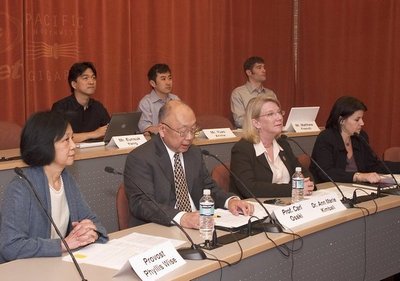June 26, 2008
Pacific Rim health officials tackle pandemic influenza
Faced by concerns that the current bird flu epidemic could become the next global human flu pandemic, UW researchers joined public health officials from 16 Pacific Rim economies May 29 for a real-time virtual video conference to tackle the challenge of pandemic influenza preparedness and response. The focus: public/private cooperation in sustaining critical infrastructure during a pandemic.
From Peru to Australia, from China to Mexico, the 16 member countries of the Asia-Pacific Economic Cooperation Emerging Infections Network (APEC EINet) were able to convene in a third-floor room of the UW’s Odegaard Library — while, at the same time, remaining in their respective countries — thanks to real-time video conferencing made possible by Access Grid and polycom multipoint technology.
This software technology takes advantage of high-speed research and education networks, allowing for connection to multiple sites with computer screen sharing and video conferencing.
For those from the Americas, it was the evening of May 29; for those in Asia, it was the morning of May 30. The goal was to bring together world economies in a real-time virtual exchange of current practices, new ideas, and dynamic discussion on ways to enhance pandemic preparedness and response across borders.
Private sector partners — from business service organizations, manufacturing, power and utility, and agriculture — participated alongside public sector representatives in a rich discussion of how commerce and health can collaborate in population preparedness.
Infectious disease experts say the pandemic avian influenza risk is probably expanding. Today, the H5N1 virus, a fast-mutating avian influenza virus that has caused infections in birds and humans, persists on three continents and has infected humans in Indonesia, Egypt, and China so far this year.
“Public sector alone clearly is not strong enough to withstand the impact of a pandemic without strong collaboration from private sector partners,” said Dr. Ann Marie Kimball, UW professor of epidemiology and director of APEC EINet.
“The avian flu threat mandates that we work together collaboratively to develop effective methods to prepare for and respond to a potential pandemic. In order to improve preparedness regionally,” Kimball said, “it is vital to understand how each economy in the broader Asia-Pacific region is undertaking preparedness. The virtual symposium is our opportunity to learn from one another.”
The ability to host a real-time virtual interchange will also enhance future collaboration and response in the event of a pandemic, Kimball said.
“During an actual pandemic, this virtual medium would be a safe way to communicate when international travel is limited or prohibited,” she said.
Virtual symposium participants included the UW APEC Emerging Infections Network team, UN officials, the Asia-Pacific Economic Cooperation and the APEC Business Advisory Council. Peru, as “Lead Shepherd” for APEC in 2008, led off the discussion with its Minister of Health, the Honorable Hernan Garrido Lecca, presenting. Representatives from the U.S., Australia, Brunei Darussalam, Canada, China, Indonesia, Japan, Korea, Malaysia, Mexico, Papua New Guinea, Philippines, Singapore, Taipei, Thailand and Vietnam then presented their situations and engaged in discussion.
In keeping with the symposium’s theme of “Public/Private Cooperation for Pandemic Preparedness,” each country’s public health and business representatives shared examples of lessons learned and current practices in place for preparedness planning, including scenario exercises, communication drills, stockpiling, and policy evaluation.
They described how private and public sectors in the APEC region can cooperate and work effectively to prepare for and respond to an influenza pandemic. Participants were also able to share Web-based and other electronic information with each other throughout the symposium.
The May 29 symposium marked the second time this alliance of government and academic partners with experts in pandemic preparedness and technology convened to communicate in real-time about the fight against regional pandemics. The first APEC EINet virtual symposium on pandemic influenza preparedness was held in January 2006 “with great success,” Kimball said.
“This was our second experiment bringing state-of-the-art high-speed communications tools into the regional mission of public health,” she said. “And it worked beautifully.”



